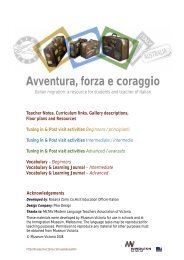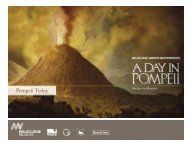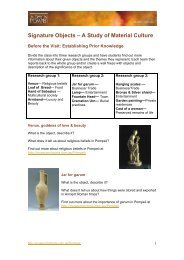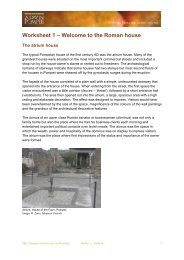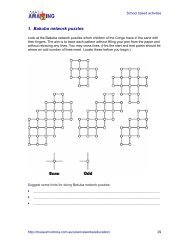Callaloo: the Caribbean Mix in Victoria - Museum Victoria
Callaloo: the Caribbean Mix in Victoria - Museum Victoria
Callaloo: the Caribbean Mix in Victoria - Museum Victoria
Create successful ePaper yourself
Turn your PDF publications into a flip-book with our unique Google optimized e-Paper software.
Community Community Exh Exhibition Program<br />
<strong>Callaloo</strong><br />
The <strong>Caribbean</strong> <strong>Mix</strong> <strong>in</strong> <strong>Victoria</strong>
<strong>Callaloo</strong>:<br />
mix<strong>in</strong>g it up<br />
<strong>Callaloo</strong> is a leafy green vegetable grown<br />
and eaten throughout <strong>the</strong> <strong>Caribbean</strong>.<br />
<strong>Callaloo</strong> is a rich, blended soup, a spicy and nourish<strong>in</strong>g<br />
mix of callaloo leaves, okra, pumpk<strong>in</strong>, salt meat or<br />
crab and coconut milk, all seasoned with thyme and<br />
hot pepper.<br />
<strong>Callaloo</strong> is an idea, a word to describe <strong>the</strong> wonderfully<br />
diverse mixture of races and cultures that defi ne<br />
<strong>Caribbean</strong> people.<br />
From <strong>the</strong> earliest days of European settlement, West<br />
Indians have been present <strong>in</strong> Australia <strong>in</strong> very small<br />
numbers. Because <strong>the</strong>re are so few of us, we seek<br />
each o<strong>the</strong>r out and ‘mix’ socially, regardless of our<br />
cultural differences or country of orig<strong>in</strong>. We also choose<br />
partners from many o<strong>the</strong>r ethnic groups, ‘mix<strong>in</strong>g it up’<br />
even fur<strong>the</strong>r.<br />
Celebrate with us <strong>the</strong> richness and diversity that is <strong>the</strong><br />
West Indian experience, <strong>the</strong> <strong>Caribbean</strong> callaloo.<br />
below<br />
Members of <strong>the</strong> <strong>Caribbean</strong> community dressed as <strong>the</strong><br />
‘Four Seasons’ <strong>in</strong> <strong>the</strong> Moomba Festival Parade, 1997.<br />
Source: <strong>Museum</strong> <strong>Victoria</strong> <strong>Caribbean</strong> Community Photographic Collection.
The chattel house<br />
Chattel house is one name for modest,<br />
often brightly coloured, little houses<br />
found all over <strong>the</strong> <strong>Caribbean</strong> islands.<br />
opposite, clockwise from top left<br />
A typical chattel house <strong>in</strong> <strong>the</strong> style found<br />
throughout <strong>the</strong> islands of <strong>the</strong> <strong>Caribbean</strong>.<br />
Artist and date unknown.<br />
The home of Elvira Lambert reflected<br />
some of <strong>the</strong> typical architectual features<br />
of chattel houses. Here mourners pay <strong>the</strong>ir<br />
respects at her home after her funeral.<br />
K<strong>in</strong>gston, Jamaica, 1931.<br />
The Smith children, who migrated to<br />
Australia <strong>in</strong> <strong>the</strong> late 1960s with <strong>the</strong>ir<br />
parents, are pictured stand<strong>in</strong>g <strong>in</strong> front of<br />
Aunt Hettie’s chattel house <strong>in</strong> Tr<strong>in</strong>idad,<br />
c. 1956.<br />
Source: <strong>Museum</strong> <strong>Victoria</strong> <strong>Caribbean</strong> Community<br />
Photographic Collection.<br />
right<br />
En route to Australia <strong>in</strong> 1975, Ingrid Jarvis<br />
revisited what was left of her family’s chattel<br />
house <strong>in</strong> Barbados, where she was born.<br />
Source: <strong>Museum</strong> <strong>Victoria</strong> <strong>Caribbean</strong> Community<br />
Photographic Collection.<br />
In <strong>the</strong> post-slavery plantation economies, <strong>the</strong>se were<br />
orig<strong>in</strong>ally houses for tenant workers. ‘Chattel’ is a legal<br />
term mean<strong>in</strong>g moveable property and <strong>the</strong>se houses<br />
often were not set on permanent foundations. In <strong>the</strong><br />
event of a dispute with <strong>the</strong> landowners, <strong>in</strong> some islands<br />
it was not uncommon for workers to simply pick up <strong>the</strong>ir<br />
house and move it to ano<strong>the</strong>r location.<br />
Some of <strong>the</strong> architectural features of chattel houses<br />
are found <strong>in</strong> o<strong>the</strong>r houses <strong>in</strong> <strong>the</strong> <strong>Caribbean</strong>. The liv<strong>in</strong>g<br />
rooms of West Indian migrants are often decorated with<br />
pa<strong>in</strong>t<strong>in</strong>gs, sketches or even m<strong>in</strong>iature reproductions of<br />
chattel houses. They are a strong shared rem<strong>in</strong>der of<br />
home, and a unify<strong>in</strong>g symbol for West Indian migrants<br />
from all backgrounds.<br />
This idea of a home you take with you is rem<strong>in</strong>iscent<br />
of <strong>the</strong> migration experience and of West Indians<br />
establish<strong>in</strong>g lives <strong>in</strong> a new country.
Who are<br />
West Indians?<br />
The <strong>Caribbean</strong> Sea is bordered by North America,<br />
South America, Central America to <strong>the</strong> west<br />
and <strong>the</strong> Atlantic Ocean to <strong>the</strong> east. It takes its<br />
name from <strong>the</strong> <strong>in</strong>digenous Caribs who <strong>in</strong>habited<br />
this region.<br />
The name West Indies was co<strong>in</strong>ed by Christopher<br />
Columbus <strong>in</strong> 1492, who mistakenly thought he’d<br />
reached India. The British used it to describe <strong>the</strong>ir<br />
colonies on <strong>the</strong> islands and coastl<strong>in</strong>es of <strong>the</strong> <strong>Caribbean</strong>.<br />
Today, <strong>the</strong> ‘West Indies’ refers to a group of ma<strong>in</strong>ly<br />
English-speak<strong>in</strong>g dependencies, territories and<br />
<strong>in</strong>dependent <strong>Caribbean</strong> countries, many of which<br />
are members of <strong>the</strong> Commonwealth. Because most<br />
<strong>Caribbean</strong> migrants to Australia are West Indian,<br />
<strong>the</strong> terms ‘<strong>Caribbean</strong>’ and ‘West Indian’ are used<br />
<strong>in</strong>terchangeably here.<br />
Most West Indian people have a complex ancestry<br />
<strong>in</strong>clud<strong>in</strong>g African slaves, Indian <strong>in</strong>dentured workers and<br />
<strong>the</strong> region’s colonisers from Brita<strong>in</strong>, France, Spa<strong>in</strong> and<br />
<strong>the</strong> Ne<strong>the</strong>rlands. Some of our heritage also comes from<br />
<strong>in</strong>digenous Amer<strong>in</strong>dians, as well as European Jews and<br />
later settlers from Ch<strong>in</strong>a, Madeira, Lebanon and Syria.<br />
No wonder we believe ours were among <strong>the</strong> fi rst<br />
multicultural societies <strong>in</strong> <strong>the</strong> world!<br />
Due to our ethnic diversity, even West Indians from<br />
<strong>the</strong> same country do not usually look alike, and migrants<br />
don’t always recognise each o<strong>the</strong>r. Often we only<br />
stumble across ano<strong>the</strong>r West Indian by overhear<strong>in</strong>g<br />
a familiar accent.
Lim<strong>in</strong>’<br />
Relaxed and <strong>in</strong>formal hospitality is an<br />
important part of West Indian culture.<br />
It is normal for visitors to drop <strong>in</strong><br />
unannounced and be welcomed with<br />
an enthusiastic ‘Come <strong>in</strong>, man!’ Food<br />
and dr<strong>in</strong>k are always offered dur<strong>in</strong>g <strong>the</strong>se<br />
spontaneous visits.<br />
top to bottom<br />
Sundown dr<strong>in</strong>ks <strong>in</strong> Kate Lasalle’s backyard <strong>in</strong><br />
Tr<strong>in</strong>idad, 1978.<br />
The ‘whole lime’, a large ga<strong>the</strong>r<strong>in</strong>g at Ingrid and<br />
Rodney Jarvis’ home at Yarra Junction, c. 1988.<br />
<strong>Mix</strong><strong>in</strong>g it up with newfound friends and family<br />
<strong>in</strong> Upwey, <strong>Victoria</strong>, 1979.<br />
Lim<strong>in</strong>g <strong>in</strong> a Tr<strong>in</strong>idad kitchen, <strong>Caribbean</strong> style,<br />
1987.<br />
Source: <strong>Museum</strong> <strong>Victoria</strong> <strong>Caribbean</strong> Community<br />
Photographic Collection.<br />
A feature of daily life <strong>in</strong> <strong>the</strong> <strong>Caribbean</strong> is lim<strong>in</strong>g<br />
(pronounced lim<strong>in</strong>’ ) when a group of people get toge<strong>the</strong>r<br />
<strong>in</strong>formally and share conversation, jokes and laughter,<br />
often for hours at a time. This is also called buss<strong>in</strong>’ a lime.<br />
A popular pastime at any time of day or night, lim<strong>in</strong>g<br />
is usually accompanied by dr<strong>in</strong>ks (such as local rum or<br />
beer) and tasty tidbits, known as cutters. Lim<strong>in</strong>g takes<br />
place anywhere: at home <strong>in</strong> kitchens or on verandahs,<br />
<strong>in</strong> sports clubs, <strong>in</strong> ‘rumshops’ or just sitt<strong>in</strong>g around<br />
outdoors and on street corners.<br />
When <strong>Caribbean</strong> people migrate to places like<br />
Melbourne, <strong>the</strong> faster pace of life, colder climate and<br />
longer travell<strong>in</strong>g distances all comb<strong>in</strong>e to make such<br />
<strong>in</strong>formal get-toge<strong>the</strong>rs more diffi cult. West Indian<br />
migrants ma<strong>in</strong>ta<strong>in</strong> this vital aspect of <strong>the</strong>ir culture <strong>in</strong> new<br />
ways by organis<strong>in</strong>g frequent parties, cultural picnics and<br />
events such as <strong>the</strong> annual Australia Day ‘Cricket Lime’<br />
<strong>in</strong> <strong>Victoria</strong>.
<strong>Caribbean</strong> food:<br />
historically delicious!<br />
<strong>Caribbean</strong> food is a vibrant fusion of<br />
cultural <strong>in</strong>fluences reflect<strong>in</strong>g our rich<br />
and complex history.<br />
above<br />
A selection of popular West Indian dishes,<br />
<strong>in</strong>clud<strong>in</strong>g stew, curry and rice.<br />
opposite, clockwise from top<br />
Serv<strong>in</strong>g coo coo, a popular dish made<br />
with cornmeal and okra, at <strong>the</strong> West Indian<br />
Cultural Day, 2008.<br />
Pone, p<strong>in</strong>eapple up-side-down cake and<br />
sweetbread.<br />
The children got <strong>the</strong> best, <strong>the</strong> adults ate <strong>the</strong><br />
rest.’ Spicy food was a normal part of <strong>the</strong>ir fare.<br />
Coo coo and fish; rice and peas.<br />
A favourite soup throughout <strong>the</strong> <strong>Caribbean</strong>,<br />
callaloo cooked with sp<strong>in</strong>ach, crabs and spices.<br />
(See recipe overleaf).<br />
‘Cutters’ or light snacks with doubles and souse.<br />
Photographer: David Loram.<br />
Source: <strong>Museum</strong> <strong>Victoria</strong> <strong>Caribbean</strong> Community<br />
Photographic Collection.<br />
The <strong>in</strong>digenous Caribs and Arawaks made bread, grew<br />
corn, cassava, sweet potatoes, arrowroot, tomatoes,<br />
chillies and o<strong>the</strong>r crops, and ate a wide variety of fruit,<br />
shellfi sh, turtle and game. The Arawaks, grill<strong>in</strong>g <strong>the</strong>ir<br />
meat over open fi res us<strong>in</strong>g frames of th<strong>in</strong> sticks called<br />
barbacoa, gave <strong>the</strong> world <strong>the</strong> word ‘barbeque’.<br />
Sugar cane was <strong>the</strong> basis of <strong>the</strong> <strong>Caribbean</strong> economy<br />
and required <strong>in</strong>tensive labour. European colonisers<br />
<strong>in</strong>troduced many foods from around <strong>the</strong> world to<br />
supplement <strong>the</strong> local food sources: breadfruit, taro,<br />
ackees, okra, yams and planta<strong>in</strong>s from Africa as well<br />
as salt fi sh and rice, to name just a few. Indentured<br />
workers from Ch<strong>in</strong>a and India brought <strong>the</strong>ir chow me<strong>in</strong>s,<br />
curries, rotis and snack foods. West Indian cooks created<br />
many cross-cultural or ‘creolised’ dishes, which were<br />
eaten by everyone.<br />
<strong>Caribbean</strong> recipes cont<strong>in</strong>ue to evolve <strong>in</strong> Australia as<br />
West Indian immigrants experiment with local<br />
<strong>in</strong>gredients. For example, we now substitute sp<strong>in</strong>ach<br />
leaves when mak<strong>in</strong>g our ‘crab and callaloo’ dish. We are<br />
passionate about pass<strong>in</strong>g down our food traditions for<br />
<strong>the</strong> next generation to enjoy!
above<br />
Souvenir cricket bats signed by West Indian<br />
visit<strong>in</strong>g team members.<br />
Photographs: David Loram<br />
Melbourne’s daily newspapers gave extensive<br />
coverage of <strong>the</strong> thrill<strong>in</strong>g conclusion to <strong>the</strong> 1961<br />
West Indies cricket tour <strong>in</strong>clud<strong>in</strong>g commentary<br />
on <strong>the</strong> migration policy of <strong>the</strong> day.<br />
Courtesy: <strong>the</strong> Age and Herald Sun.<br />
Crab ‘n’ <strong>Callaloo</strong><br />
Recipe courtesy Jacquel<strong>in</strong>e Dedier<br />
2 fresh crabs<br />
3 boxes frozen sp<strong>in</strong>ach<br />
20 okra<br />
½ kg pumpk<strong>in</strong>, preferably Jap<br />
1 can Thai brand coconut milk<br />
4 cloves garlic<br />
4 spr<strong>in</strong>g onions<br />
1 brown onion<br />
1 whole red chilli (optional)<br />
small handful fresh thyme<br />
small handful parsley<br />
salt & black pepper to taste<br />
METHOD<br />
Dasheen (taro) leaves can be substituted with frozen sp<strong>in</strong>ach.<br />
Remove tops of okra and slice <strong>in</strong> rounds. Chop pumpk<strong>in</strong> <strong>in</strong><br />
small pieces.<br />
Chop all o<strong>the</strong>r <strong>in</strong>gredients except chilli. Place frozen sp<strong>in</strong>ach<br />
<strong>in</strong> deep saucepan with okra, pumpk<strong>in</strong> and chilli (optional),<br />
steam slowly. Add season<strong>in</strong>g and coconut milk, stir.<br />
Place crab claws on top, add water to cover and simmer for<br />
30–45 m<strong>in</strong>utes until crab is cooked and looks red <strong>in</strong> colour.<br />
Lift crab out and set aside <strong>in</strong> serv<strong>in</strong>g bowl. Remove whole chilli<br />
pepper and set aside.<br />
Add small amounts of hot callaloo mixture at a time <strong>in</strong>to food<br />
processor or blender and puree, with a small piece of chilli<br />
pepper (optional).<br />
Add to crab <strong>in</strong> bowl and repeat until all <strong>the</strong> callaloo is pureed.<br />
Return to pot and cook slowly. Add salt and black pepper to taste.<br />
Serve over rice or eat as a soup with <strong>the</strong> crab claws. F<strong>in</strong>ger bowl<br />
and side plate necessary.<br />
Useful Tip: Never use a metal spoon <strong>in</strong> <strong>Callaloo</strong> or Hot Pepper Sauce.<br />
this page, from top to bottom<br />
Rupert ‘Monty’ Montague, with Jim<br />
Vlassopoulos, <strong>in</strong>side <strong>the</strong> second Jamaica<br />
House restaurant, Carlton, 1971.<br />
Source: <strong>Museum</strong> <strong>Victoria</strong> <strong>Caribbean</strong> Community<br />
Photographic Collection.<br />
Mortar and pestle.<br />
A range of practical and decorative swizzle<br />
sticks traditionally used for blend<strong>in</strong>g<br />
<strong>Callaloo</strong> soup and dhal, whisk<strong>in</strong>g eggs<br />
and o<strong>the</strong>r blend<strong>in</strong>g.<br />
Jamaica House menus and recipe book.<br />
The restaurant was <strong>the</strong> first <strong>in</strong> Australia<br />
to serve <strong>Caribbean</strong> food, open<strong>in</strong>g <strong>in</strong> 1966.<br />
Photographs: David Loram
top to bottom<br />
Steelpan drum left beh<strong>in</strong>d when <strong>the</strong> Amral<br />
Cavalliers band toured <strong>Victoria</strong> <strong>in</strong> 1978.<br />
The cuatro, four-str<strong>in</strong>ged m<strong>in</strong>i guitar, popular<br />
<strong>in</strong> Tr<strong>in</strong>idad and used to play parang music.<br />
Chac-chac, a <strong>Caribbean</strong> percussion<br />
<strong>in</strong>strument that accompanies parang music.<br />
at right<br />
Iron brake drum used as a percussion<br />
<strong>in</strong>strument <strong>in</strong> <strong>Caribbean</strong> music.<br />
Photographs: David Loram<br />
above and at left<br />
Details of Persian-<strong>the</strong>med Tr<strong>in</strong>idad<br />
carnival costumes brought back by<br />
West Indian migrants.<br />
A West Indian folkloric costume used<br />
<strong>in</strong> cultural performances.<br />
Photographs: David Loram
The West Indies<br />
and Australia<br />
Connections between <strong>the</strong> West Indies<br />
and Australia began <strong>in</strong> <strong>the</strong> early days<br />
of European settlement.<br />
clockwise from top right<br />
Ralph de Boissiere, of <strong>the</strong> Realist Writers<br />
Group, arrived <strong>in</strong> Australia from Tr<strong>in</strong>idad<br />
with his family <strong>in</strong> 1947.<br />
Source: <strong>Museum</strong> <strong>Victoria</strong> <strong>Caribbean</strong> Community<br />
Photographic Collection.<br />
Cocoa Jackson Lane, was named as a<br />
tribute to respected local identity, West<br />
Indian Fred James, who lived <strong>in</strong> Edward<br />
Street Brunswick from 1930 to 1979.<br />
Source: <strong>Museum</strong> <strong>Victoria</strong> <strong>Caribbean</strong> Community<br />
Photographic Collection.<br />
Portrait of Peter Felix, taken between<br />
1895 and 1899. Peter Felix, a West Indian<br />
migrant from St Croix who settled <strong>in</strong><br />
Melbourne, became Australian Box<strong>in</strong>g<br />
Heavyweight Champion <strong>in</strong> <strong>the</strong> late 1890s.<br />
Courtesy National Library of Australia,<br />
Image No. NLA 3638961<br />
Farewell d<strong>in</strong>ner for visit<strong>in</strong>g African-<br />
American heavyweight boxer Jack Johnson<br />
(centre back <strong>in</strong> light suit), held by <strong>the</strong><br />
Coloured Progressive Association, Sydney,<br />
1907. Those pictured <strong>in</strong>clude West Indian<br />
boxer, Peter Felix (large man to Johnson’s<br />
left) and Aborig<strong>in</strong>al activist Fred Maynard<br />
(seated <strong>in</strong> front of waistcoated man).<br />
Source: Courtesy John Maynard.<br />
Australia’s fi rst newspaper publisher, and founder of <strong>the</strong><br />
Sydney Gazette <strong>in</strong> 1803 was George Howe, a white convict<br />
from <strong>the</strong> island of St Christopher.<br />
At <strong>the</strong> height of <strong>the</strong> British Empire, offi cers and<br />
adm<strong>in</strong>istrators moved freely between far-fl ung colonies.<br />
Many came to Australia from <strong>the</strong> West Indies while o<strong>the</strong>rs,<br />
like Edward Eyre, left Australia to take up appo<strong>in</strong>tments<br />
<strong>the</strong>re.<br />
Black convicts, servants and sailors from <strong>the</strong> West Indies<br />
also arrived <strong>in</strong> Australia and many of <strong>the</strong>m later <strong>in</strong>tegrated<br />
<strong>in</strong>to Aborig<strong>in</strong>al communities. These relationships, and l<strong>in</strong>ks<br />
forged through <strong>the</strong> sport of box<strong>in</strong>g, contributed to later<br />
alliances between <strong>the</strong> Black Consciousness movements <strong>in</strong><br />
Australia, <strong>the</strong> USA and <strong>the</strong> West Indies, <strong>in</strong>clud<strong>in</strong>g a branch of<br />
Marcus Garvey’s Universal Negro Improvement Association<br />
<strong>in</strong> Sydney <strong>in</strong> <strong>the</strong> 1920s.<br />
<strong>Caribbean</strong> people were also among <strong>the</strong> many nationalities<br />
fl ock<strong>in</strong>g to <strong>the</strong> <strong>Victoria</strong>n goldfi elds after 1851. One of<br />
<strong>the</strong> thirteen m<strong>in</strong>ers killed at <strong>the</strong> Eureka Stockade was a<br />
Jamaican. Arthur W<strong>in</strong>dsor, editor of <strong>the</strong> Age newspaper<br />
from 1872 – 1900 was born <strong>in</strong> Barbados.<br />
Especially s<strong>in</strong>ce <strong>the</strong> abandonment of <strong>the</strong> White Australia<br />
policy, West Indians have arrived from many countries of<br />
<strong>the</strong> Commonwealth. From honky-tonk pianist W<strong>in</strong>ifred<br />
Atwell to environmental eng<strong>in</strong>eer Ken Potter and writer<br />
Ralph de Boissiere, <strong>the</strong>y have brought wide-rang<strong>in</strong>g skills,<br />
experience and cultural richness to Australia.
top to bottom<br />
Letter received by Michael Ward, who<br />
migrated from Jamaica shortly before <strong>the</strong><br />
abolition of <strong>the</strong> White Australia Policy.<br />
The Phillips family at home <strong>in</strong> Georgetown,<br />
Guyana, 1976, ga<strong>the</strong>red to farewell eldest<br />
sister Joan Buchanan (second right) <strong>the</strong> day<br />
before she and husband George (third right)<br />
left for Australia.<br />
Michael and Adrienne Ward, at <strong>the</strong>ir home<br />
<strong>in</strong> Melbourne, 2009.<br />
The Thomas family from Tabago, posed<br />
for this photograph to accompany <strong>the</strong>ir<br />
immigration application for migration to<br />
Australia <strong>in</strong> 1962.<br />
Gordon Veerasawmy received a warm<br />
welcome from his family upon arriv<strong>in</strong>g<br />
at Melbourne Airport <strong>in</strong> 1996.<br />
Tony and Schavana Phillips followed Joan<br />
Buchanan, Tony’s sister, to Australia,<br />
arriv<strong>in</strong>g <strong>in</strong> Perth <strong>in</strong> 1978.<br />
Source: <strong>Museum</strong> <strong>Victoria</strong> <strong>Caribbean</strong> Community<br />
Photographic Collection.<br />
Few and far away<br />
<strong>Caribbean</strong> migrants are often asked<br />
why <strong>the</strong>y left <strong>the</strong>ir tropical homes to<br />
travel across <strong>the</strong> world and live <strong>in</strong><br />
temperate Melbourne. The reasons<br />
why West Indians came to <strong>Victoria</strong><br />
are as varied as <strong>the</strong> people <strong>the</strong>mselves.<br />
above<br />
Rupert ‘Monty’ Montague migrated to England<br />
from Jamaica <strong>in</strong> 1943. In 1964 he married<br />
Stephanie Burchett (later Alexander), an<br />
Australian who was temporarily liv<strong>in</strong>g <strong>in</strong><br />
London. Monty <strong>the</strong>n embarked on a ‘second<br />
migration’ to Australia where he and Stephanie<br />
opened <strong>the</strong> first West Indian restaurant <strong>in</strong><br />
Melbourne, Jamaica House <strong>in</strong> Carlton, <strong>in</strong> 1966.<br />
Source: <strong>Museum</strong> <strong>Victoria</strong> <strong>Caribbean</strong> Community<br />
Photographic Collection.<br />
Dur<strong>in</strong>g <strong>the</strong> many years of <strong>the</strong> White Australia Policy,<br />
it was extremely diffi cult for non-white West Indians<br />
to migrate to Australia. Many early migrants were middleclass<br />
‘white-enough’ West Indians from some <strong>Caribbean</strong><br />
countries where political unrest and economic uncerta<strong>in</strong>ty<br />
accompanied <strong>in</strong>dependence around <strong>the</strong> 1960s. Follow<strong>in</strong>g<br />
<strong>the</strong> abolition of <strong>the</strong> White Australia Policy <strong>in</strong> 1975, West<br />
Indians of all races were gradually able to migrate more<br />
freely.<br />
Love frequently brought West Indians to Australia. Many<br />
marriages occurred <strong>in</strong> <strong>the</strong> 1960s and 1970s, when young<br />
Australians on <strong>the</strong>ir ‘rite of passage’ trips to Great Brita<strong>in</strong><br />
met West Indians, with whom <strong>the</strong>y shared similar attitudes<br />
to life, education, values and sense of humour.<br />
The <strong>Caribbean</strong> community has grown <strong>in</strong> recent years as<br />
younger and second-generation immigrants born <strong>in</strong> Brita<strong>in</strong>,<br />
<strong>the</strong> USA and Canada have started migrat<strong>in</strong>g to Australia.<br />
Accord<strong>in</strong>g to <strong>the</strong> Australian Bureau of Statistics Census<br />
2006, around 1200 <strong>Victoria</strong>ns claim West Indian ancestry.
clockwise from top left<br />
Karen Greenidge, migrated from T<strong>in</strong>idad<br />
<strong>in</strong> 1989 shortly after be<strong>in</strong>g named<br />
Sportswoman of <strong>the</strong> Year for her golf and<br />
tennis prowess. Pictured here with cricketer<br />
Brian Lara who later won <strong>the</strong> same award,<br />
at a party held for him by <strong>the</strong> West Indian<br />
community, Melbourne 2006.<br />
The first Australia Day cricket match and<br />
West Indian Family Day, <strong>in</strong> 1992.<br />
Tony Phillips, Malcolm McDonald and Ivan<br />
Veerasawmy at a West Indies match at <strong>the</strong><br />
MCG, c.1995.<br />
Members of <strong>the</strong> <strong>Caribbean</strong> community look<br />
forward to host<strong>in</strong>g <strong>the</strong> visit<strong>in</strong>g West Indies<br />
cricket team when <strong>the</strong>y are <strong>in</strong> Australia.<br />
Here <strong>the</strong>y are at d<strong>in</strong>ner with Clive Lloyd.<br />
West Indians enjoy<strong>in</strong>g a day at <strong>the</strong> cricket.<br />
Source: <strong>Museum</strong> <strong>Victoria</strong> <strong>Caribbean</strong> Community<br />
Photographic Collection.<br />
Calypso cricket:<br />
los<strong>in</strong>g <strong>the</strong> series<br />
but w<strong>in</strong>n<strong>in</strong>g hearts<br />
Cricket is a passion among many<br />
West Indians. From <strong>the</strong> mid-1970s<br />
to early 1990s, West Indies cricket<br />
teams were <strong>the</strong> strongest <strong>in</strong> <strong>the</strong> world.<br />
above<br />
Melbourne’s daily newspapers gave extensive<br />
coverage of <strong>the</strong> thrill<strong>in</strong>g conclusion to <strong>the</strong><br />
1961 West Indies cricket tour <strong>in</strong>clud<strong>in</strong>g<br />
commentary on <strong>the</strong> migration policy of <strong>the</strong> day.<br />
Courtesy: <strong>the</strong> Age.<br />
Keen rivalry produced many thrill<strong>in</strong>g encounters with<br />
Australia over <strong>the</strong> years. The traditional Box<strong>in</strong>g Day Test<br />
held at <strong>the</strong> Melbourne Cricket Ground is a popular meet<strong>in</strong>g<br />
place whenever <strong>the</strong> ‘W<strong>in</strong>dies’ come on tour. West Indians<br />
<strong>in</strong> <strong>Victoria</strong> always turn out to meet ‘<strong>the</strong> boys from back<br />
home’ and each o<strong>the</strong>r.<br />
One famous tour of Australia was <strong>the</strong> 1960–61<br />
Test series. Both Frank Worrell, <strong>the</strong> fi rst black man<br />
to lead <strong>the</strong> West Indies team abroad, and his oppos<strong>in</strong>g<br />
capta<strong>in</strong>, Richie Benaud, encouraged <strong>the</strong>ir teams to play<br />
attack<strong>in</strong>g cricket.<br />
The fi rst Test match produced <strong>the</strong> only ‘Tied Test’ <strong>in</strong> 123<br />
years, and <strong>the</strong> subsequent close contest electrifi ed <strong>the</strong><br />
entire cricket world. The series climax at <strong>the</strong> MCG broke an<br />
<strong>in</strong>ternational crowd record of 90,800. A ticker tape parade<br />
drew 20,000 cheer<strong>in</strong>g fans to downtown Melbourne to<br />
farewell <strong>the</strong> West Indies team, who had lost 2–1.<br />
At <strong>the</strong> height of <strong>the</strong> White Australia Policy, <strong>the</strong>se stylish,<br />
articulate and multi-racial West Indian players aroused <strong>the</strong><br />
curiosity and admiration of <strong>the</strong> public. The success of this<br />
tour added to mount<strong>in</strong>g calls to repeal Australia’s racist<br />
immigration law.
top to bottom<br />
Musicians <strong>in</strong> <strong>the</strong> mak<strong>in</strong>g: <strong>the</strong> next<br />
generation of West Indians <strong>in</strong> <strong>Victoria</strong><br />
learn <strong>the</strong> basics of play<strong>in</strong>g <strong>the</strong> bottle and<br />
spoon and <strong>the</strong> ‘iron’ brake drum.<br />
The West Indian <strong>the</strong>me for <strong>the</strong> 2008<br />
Moomba parade was Pirates of <strong>the</strong><br />
<strong>Caribbean</strong>.<br />
West Indians, accompanied by friends, take<br />
part <strong>in</strong> <strong>the</strong>ir first Moomba Parade, 1975.<br />
The West Indians entry <strong>in</strong> <strong>the</strong> Moomba<br />
Festival parade, 1975.<br />
Primary school students learn about<br />
<strong>Caribbean</strong> music from Charles Blakeman<br />
who is play<strong>in</strong>g <strong>the</strong> steel pan drum, 2006.<br />
opposite page<br />
The Amral Cavaliers band toured Australia<br />
<strong>in</strong> 1978 and left <strong>the</strong>ir steel pans beh<strong>in</strong>d for<br />
<strong>the</strong> local community to play.<br />
Source: <strong>Museum</strong> <strong>Victoria</strong> <strong>Caribbean</strong> Community<br />
Photographic Collection.<br />
West Indian music<br />
and carnival<br />
Carnival is a major <strong>Caribbean</strong> festival,<br />
when revellers from every social class<br />
throw off all <strong>in</strong>hibitions. To play mas’<br />
(participate <strong>in</strong> Carnival) is to don a<br />
colourful costume, become anonymous<br />
and dance <strong>in</strong> <strong>the</strong> streets to <strong>the</strong> pulsat<strong>in</strong>g<br />
rhythms of <strong>the</strong> steelpan.<br />
Tr<strong>in</strong>idad Carnival orig<strong>in</strong>ated with slaves dress<strong>in</strong>g up <strong>in</strong> fi nery<br />
to mimic <strong>the</strong>ir Catholic masters on <strong>the</strong> two days before Ash<br />
Wednesday. On o<strong>the</strong>r islands, carnivals occur at different<br />
times. In Barbados, ‘Crop Over’ marks <strong>the</strong> end of <strong>the</strong><br />
sugarcane harvest.<br />
West Indian migrants have transported Carnival to <strong>the</strong>ir new<br />
homes overseas, such as London’s Nott<strong>in</strong>g Hill Carnival and<br />
Toronto’s Caribana. Melbourne’s t<strong>in</strong>y <strong>Caribbean</strong> community<br />
has also cont<strong>in</strong>ued its Carnival traditions by participat<strong>in</strong>g <strong>in</strong><br />
<strong>the</strong> Moomba parade s<strong>in</strong>ce 1975.<br />
Reggae and calypso are <strong>the</strong> most well-known musical<br />
styles orig<strong>in</strong>ated <strong>in</strong> <strong>the</strong> West Indies. O<strong>the</strong>rs, less famous,<br />
<strong>in</strong>clude traditional folk songs such as those popularised by<br />
Harry Belafonte, and soca, kaiso, chutney, parang, dub, ska,<br />
dancehall, toast<strong>in</strong>g and more.<br />
Famous <strong>Caribbean</strong> musicians have toured Melbourne over<br />
<strong>the</strong> years, from Bob Marley and Khan’s Tr<strong>in</strong>idad Cavaliers<br />
<strong>in</strong> <strong>the</strong> 1970s, to Calypsonian The Mighty Sparrow <strong>in</strong> 2007<br />
and Lady Saw <strong>in</strong> 2008. These rare visits provide o<strong>the</strong>r<br />
opportunities for West Indian migrants to get toge<strong>the</strong>r,<br />
celebrate <strong>the</strong>ir culture and rem<strong>in</strong>isce.
top top to to bottom bottom<br />
Lloyd Watson-Jones, shown here with his<br />
parents at Guyana airport, before board<strong>in</strong>g<br />
a plane to Australia, 1974. He came on a<br />
scholarship to study music at <strong>the</strong> Melbourne<br />
Conservatorium.<br />
Family and friends ga<strong>the</strong>red on <strong>the</strong> front<br />
lawn of <strong>the</strong> Jarvis home, to celebrate a<br />
double christen<strong>in</strong>g, c.1983.<br />
The Limbo dance is popular at many West<br />
Indian parties <strong>in</strong> <strong>Victoria</strong>, 2007.<br />
Gordon Veerasawmy received his Australian<br />
citizenship <strong>in</strong> 2001 from <strong>the</strong> Mayor of Knox,<br />
Cr Jenny Moore.<br />
Orlando and Lenford chill<strong>in</strong>’ at <strong>the</strong> West<br />
Indian community’s annual Australia Day<br />
Cricket Lime, 2009.<br />
The DeFreitas bro<strong>the</strong>rs (second left and far<br />
right) migrated from Tr<strong>in</strong>idad <strong>in</strong> 1966 and<br />
immediately volunteered for <strong>the</strong> Vietnam<br />
War. They rema<strong>in</strong>ed <strong>in</strong> touch with <strong>the</strong>ir good<br />
friends, <strong>the</strong> Thomas bro<strong>the</strong>rs, who migrated<br />
<strong>in</strong> 1967. They are shown here at one of <strong>the</strong>ir<br />
regular reunions, 1999.<br />
Source: <strong>Museum</strong> <strong>Victoria</strong> <strong>Caribbean</strong> Community<br />
Photographic Collection.<br />
Settl<strong>in</strong>g <strong>in</strong> stories<br />
The West Indians who came to Australia<br />
had different experiences from those<br />
who jo<strong>in</strong>ed established immigrant<br />
communities <strong>in</strong> <strong>the</strong> UK, USA or Canada.<br />
above, top to bottom<br />
After <strong>the</strong> children moved out, Pat and<br />
Kester Thomas downsized to a Melbournestyle<br />
chattel house! The fretwork and sound<br />
of <strong>the</strong> ra<strong>in</strong>fall on <strong>the</strong> t<strong>in</strong> roof especially<br />
rem<strong>in</strong>ded <strong>the</strong>m of <strong>the</strong>ir house <strong>in</strong> <strong>the</strong><br />
West Indies.<br />
Soon after Rodney and Ingrid Jarvis’ arrival<br />
<strong>in</strong> Melbourne <strong>in</strong> 1975, <strong>the</strong>y celebrated <strong>the</strong>ir<br />
wedd<strong>in</strong>g with <strong>the</strong>ir Australian family.<br />
Source: <strong>Museum</strong> <strong>Victoria</strong> <strong>Caribbean</strong> Community<br />
Photographic Collection.<br />
These migrants chose Australia because <strong>the</strong> lifestyle and<br />
culture sounded familiar: a beautiful country with plenty of<br />
outdoor space and sporty, ‘laid-back’ people. Many wanted<br />
to avoid cold climates and competitive, urban ‘rat race’<br />
existences. Some were also fearful of <strong>the</strong> racial tensions<br />
prevalent <strong>in</strong> many English and North American cities <strong>in</strong> <strong>the</strong><br />
1960s. Melbourne was a popular dest<strong>in</strong>ation because jobs<br />
were readily available.<br />
Early West Indian migrants faced extreme isolation, <strong>in</strong><br />
what sometimes felt like a clean, pleasant and effi cient,<br />
but slightly dull and parochial place. <strong>Victoria</strong> also proved<br />
unexpectedly cold. Even small cultural differences required<br />
some adjustment: <strong>the</strong> ‘footy’ obsession; ‘br<strong>in</strong>g-a-plate’<br />
enterta<strong>in</strong><strong>in</strong>g culture; casual dress codes; lack of domestic<br />
help or extended families; and outdoor toilets <strong>in</strong> <strong>the</strong> 1960s<br />
and 1970s!<br />
Later, migrants from more diverse social backgrounds also<br />
found <strong>the</strong>se cultural differences challeng<strong>in</strong>g. Discrim<strong>in</strong>ation<br />
was also an issue, sometimes result<strong>in</strong>g <strong>in</strong> different<br />
experiences for members of <strong>the</strong> same community – or even<br />
family – depend<strong>in</strong>g on <strong>the</strong>ir physical appearance.<br />
Despite <strong>the</strong>se problems, West Indians generally felt<br />
welcomed and accepted, and were able to build productive<br />
and comfortable new lives <strong>in</strong> <strong>Victoria</strong>. Although we are<br />
deeply nostalgic for what we left beh<strong>in</strong>d, we also celebrate<br />
our Australian identities.
Photograph: David Loram<br />
Acknowledgements<br />
<strong>Callaloo</strong> – <strong>the</strong> <strong>Caribbean</strong> <strong>Mix</strong> <strong>in</strong> <strong>Victoria</strong><br />
was <strong>in</strong>augurated at <strong>the</strong> Immigration <strong>Museum</strong><br />
at Old Customs House, Melbourne, Australia.<br />
The museum explores <strong>the</strong> stories and<br />
experiences of people from all over <strong>the</strong><br />
world who have migrated to <strong>Victoria</strong>.<br />
The Immigration <strong>Museum</strong> is part of <strong>Museum</strong> <strong>Victoria</strong><br />
which is Australia’s largest museum organisation.<br />
It is <strong>the</strong> State <strong>Museum</strong> for <strong>Victoria</strong>, responsible for <strong>the</strong><br />
care of <strong>Victoria</strong>’s collections, conduct<strong>in</strong>g research and<br />
provid<strong>in</strong>g cultural and science programs. It also operates<br />
Melbourne <strong>Museum</strong>, Scienceworks and <strong>the</strong> Royal<br />
Exhibition Build<strong>in</strong>g.<br />
THANK YOU<br />
We gratefully acknowledge those who have provided<br />
support for this exhibition, <strong>the</strong> <strong>in</strong>dividuals and families<br />
who have contributed <strong>the</strong>ir personal stories, artefacts<br />
and memorabilia. This exhibition is an achievement that<br />
will record <strong>the</strong> valuable contribution of <strong>the</strong> <strong>Caribbean</strong><br />
community to mak<strong>in</strong>g Australia a rich and diverse society.<br />
Through its Community Exhibition program, <strong>the</strong> Body text Stephanie Alexander<br />
Immigration <strong>Museum</strong> explores <strong>the</strong> different communities Charles Blakeman<br />
that have contributed to <strong>the</strong> mak<strong>in</strong>g of modern Australia. Dr Serdar Boztas<br />
<strong>Callaloo</strong> was developed by Immigration <strong>Museum</strong> <strong>in</strong><br />
collaboration with CaribVic represent<strong>in</strong>g <strong>the</strong> <strong>Caribbean</strong><br />
community <strong>in</strong> <strong>Victoria</strong>.<br />
Jigzie Campbell<br />
Jimmy Ch<strong>in</strong>nama<br />
Jacquel<strong>in</strong>e Dedier<br />
Jayne & Brian DeFreitas<br />
Maureen & Frank DeFreitas<br />
COMMUNITY EXHIBITION COMMITTEE<br />
Henry, Carla & Celeste Dolph<strong>in</strong><br />
L<strong>in</strong>coln Edwards<br />
Orlando Gibson<br />
Jacquel<strong>in</strong>e Fitch<br />
Ingrid Jarvis<br />
Dennis Gonsalves<br />
Jennai Lee Fai<br />
Jacquie Grant<br />
Lisa Montague<br />
Tony & Karen Greenidge<br />
Tony Phillips<br />
Dr. Annie Greet<br />
Joe S<strong>in</strong>gh<br />
Harry Jackson<br />
Dr. Kar<strong>in</strong>a Smith<br />
Rodney Jarvis<br />
Patricia Thomas<br />
Nigel Maharaj<br />
Leslyn Thompson<br />
Professor John Maynard<br />
Gordon Veerasawmy<br />
Tim & Gail Mew<br />
Maria Tence<br />
Peg Fraser<br />
Spurgeon Montague<br />
Sue Montague<br />
Robert Moore<br />
ADDITIONAL MATERIAL COURTESY OF<br />
National Library of Australia<br />
The Age<br />
The Herald Sun<br />
Roger & Robyn Phillips<br />
Schavana Phillips<br />
Dr Lesley Potter<br />
Gerri S<strong>in</strong>gh<br />
Madele<strong>in</strong>e Smith<br />
Maria Stratford<br />
Cover image: Jigzie Campbell,<br />
Jamaican-born perform<strong>in</strong>g artist.<br />
Photographer: J Augier, MV Collections.<br />
Cathy & Brian Thomas<br />
Kester Thomas<br />
Phillip Lyons<br />
Ivan Veerasawmy<br />
Marco Vellekoop<br />
Jim & Melita Vlassopoulos<br />
Arthur & Arlete Waite<br />
Trish Wakeford<br />
Mike & Adrienne Ward<br />
Lloyd & June Watson-Jones<br />
Kenoll Wilson
<strong>Callaloo</strong> – <strong>the</strong> <strong>Caribbean</strong> <strong>Mix</strong> <strong>in</strong> <strong>Victoria</strong> 3 December 2009 – 7 March 2010<br />
Community Exhibition Program<br />
at <strong>the</strong> Immigration <strong>Museum</strong>,<br />
Melbourne, Australia<br />
The Community Gallery presents exhibitions created by <strong>Victoria</strong>’s<br />
culturally, l<strong>in</strong>guistically and religiously diverse communities. By work<strong>in</strong>g<br />
<strong>in</strong> collaboration with <strong>the</strong> Immigration <strong>Museum</strong>, <strong>the</strong>se communities share<br />
<strong>the</strong>ir culture and heritage through <strong>the</strong>ir immigration stories.<br />
The histories and experiences of many groups have contributed to <strong>the</strong><br />
mak<strong>in</strong>g of modern Australia. The museum has collaborated with many<br />
of <strong>Victoria</strong>’s communities to develop and present exhibitions.<br />
For fur<strong>the</strong>r <strong>in</strong>formation please visit our website<br />
museumvictoria.com.au/immigrationmuseum/<br />
or <strong>the</strong> Immigration Discovery Centre on <strong>the</strong> ground fl oor.<br />
Design: Elizabeth Dias, MV Studios <strong>Museum</strong> <strong>Victoria</strong><br />
Pr<strong>in</strong>ted on Sovereign Silk – FSC certifi ed paper,<br />
manufactured with elemental chlor<strong>in</strong>e free pulps.


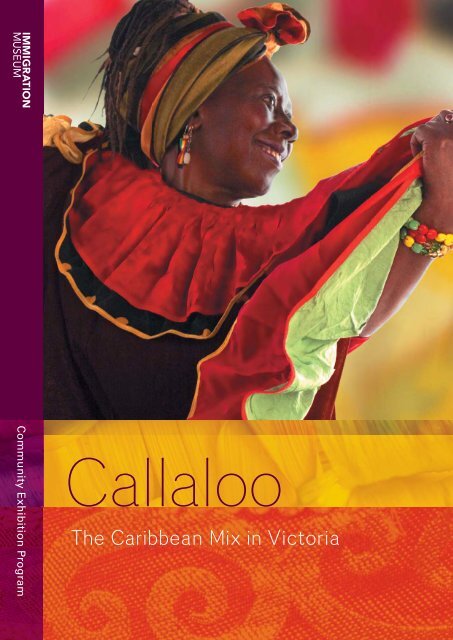
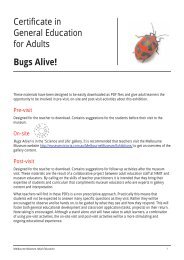


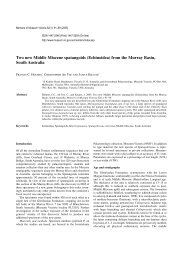
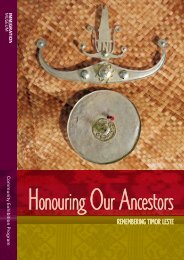
![[PDF] Andiamo a Pompei- Teacher Notes ... la - Museum Victoria](https://img.yumpu.com/16309810/1/190x245/pdf-andiamo-a-pompei-teacher-notes-la-museum-victoria.jpg?quality=85)
